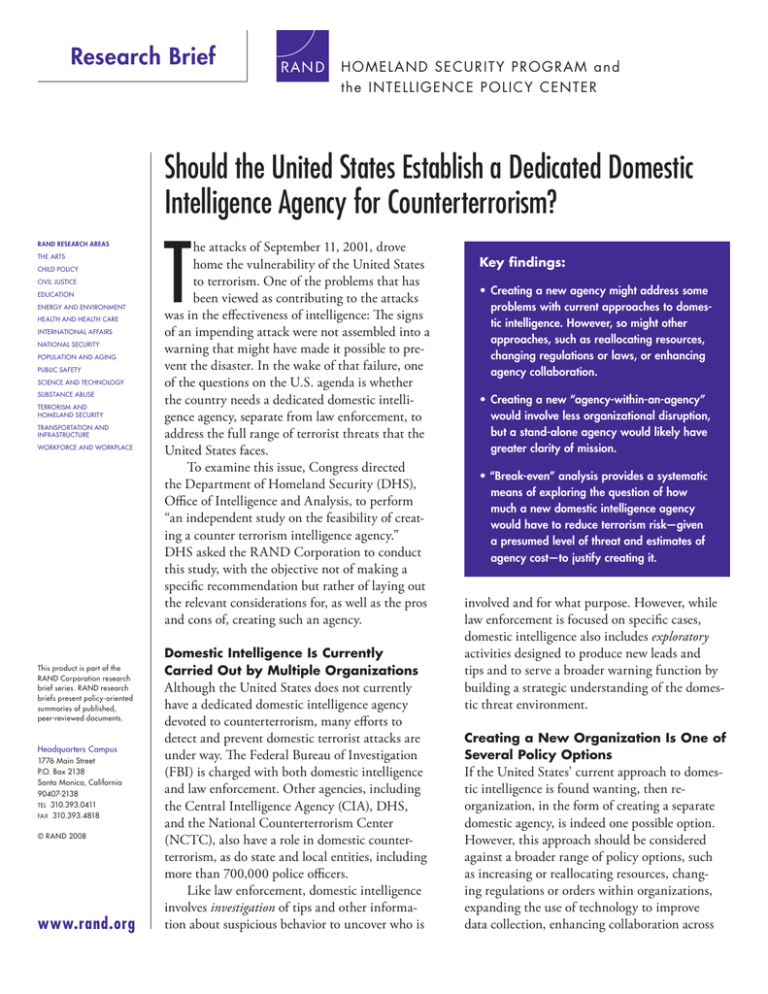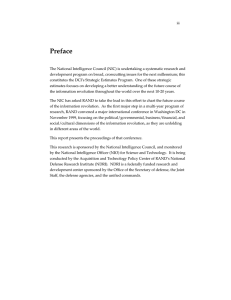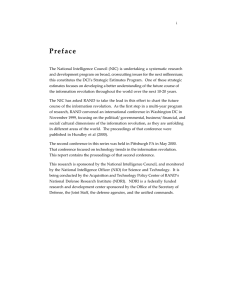T Should the United States Establish a Dedicated Domestic Research Brief
advertisement

Research Brief H O M EL AN D S EC UR ITY PR O G R AM a n d t h e IN TEL L IG EN C E POL IC Y C EN TER Should the United States Establish a Dedicated Domestic Intelligence Agency for Counterterrorism? RAND RESEARCH AREAS THE ARTS CHILD POLICY CIVIL JUSTICE EDUCATION ENERGY AND ENVIRONMENT HEALTH AND HEALTH CARE INTERNATIONAL AFFAIRS NATIONAL SECURITY POPULATION AND AGING PUBLIC SAFETY SCIENCE AND TECHNOLOGY SUBSTANCE ABUSE TERRORISM AND HOMELAND SECURITY TRANSPORTATION AND INFRASTRUCTURE WORKFORCE AND WORKPLACE This product is part of the RAND Corporation research brief series. RAND research briefs present policy-oriented summaries of published, peer-reviewed documents. Headquarters Campus 1776 Main Street P.O. Box 2138 Santa Monica, California 90407-2138 TEL 310.393.0411 FAX 310.393.4818 © RAND 2008 www.rand.org T he attacks of September 11, 2001, drove home the vulnerability of the United States to terrorism. One of the problems that has been viewed as contributing to the attacks was in the effectiveness of intelligence: The signs of an impending attack were not assembled into a warning that might have made it possible to prevent the disaster. In the wake of that failure, one of the questions on the U.S. agenda is whether the country needs a dedicated domestic intelligence agency, separate from law enforcement, to address the full range of terrorist threats that the United States faces. To examine this issue, Congress directed the Department of Homeland Security (DHS), Office of Intelligence and Analysis, to perform “an independent study on the feasibility of creating a counter terrorism intelligence agency.” DHS asked the RAND Corporation to conduct this study, with the objective not of making a specific recommendation but rather of laying out the relevant considerations for, as well as the pros and cons of, creating such an agency. Domestic Intelligence Is Currently Carried Out by Multiple Organizations Although the United States does not currently have a dedicated domestic intelligence agency devoted to counterterrorism, many efforts to detect and prevent domestic terrorist attacks are under way. The Federal Bureau of Investigation (FBI) is charged with both domestic intelligence and law enforcement. Other agencies, including the Central Intelligence Agency (CIA), DHS, and the National Counterterrorism Center (NCTC), also have a role in domestic counterterrorism, as do state and local entities, including more than 700,000 police officers. Like law enforcement, domestic intelligence involves investigation of tips and other information about suspicious behavior to uncover who is Key findings: • Creating a new agency might address some problems with current approaches to domestic intelligence. However, so might other approaches, such as reallocating resources, changing regulations or laws, or enhancing agency collaboration. • Creating a new “agency-within-an-agency” would involve less organizational disruption, but a stand-alone agency would likely have greater clarity of mission. • “Break-even” analysis provides a systematic means of exploring the question of how much a new domestic intelligence agency would have to reduce terrorism risk—given a presumed level of threat and estimates of agency cost—to justify creating it. involved and for what purpose. However, while law enforcement is focused on specific cases, domestic intelligence also includes exploratory activities designed to produce new leads and tips and to serve a broader warning function by building a strategic understanding of the domestic threat environment. Creating a New Organization Is One of Several Policy Options If the United States’ current approach to domestic intelligence is found wanting, then reorganization, in the form of creating a separate domestic agency, is indeed one possible option. However, this approach should be considered against a broader range of policy options, such as increasing or reallocating resources, changing regulations or orders within organizations, expanding the use of technology to improve data collection, enhancing collaboration across 2 Mapping Problems and Solutions The FBI, CIA, and other agencies do not talk to each other. ✓ ✓ ✓ Too much poor-quality and unverified information is collected, and collection efforts are uncoordinated. Analysis is fragmented and sometimes conflicting, and staff may lack sufficient training to perform analytical functions. It is difficult to move information and analysis across the domestic intelligence enterprise. agencies, changing laws, improving leadership, and changing organizational culture. The appropriateness of any approach depends on how the “domestic intelligence problem” is defined. To understand this issue, RAND researchers mapped possible policy approaches against several definitions of the problem (shown in the table), which were identified based on interviews, an expert panel, and a review of literature. Check marks indicate that a particular solution might be appropriate to address the corresponding problem. The table shows that changing organization might be an appropriate solution if, for example, the problem is defined in terms of the FBI’s law-enforcement approach to counterterrorism, poor cross-agency communication, or fragmented and conflicting analyses. However, a number of other approaches could also be relevant in each of these cases. Moreover, if the problem is defined in terms of the quality of the data or difficulties in information sharing, a new organization might not be the best option. And any actions taken to improve domestic intelligence should also take into account the effects they will have on privacy and civil liberties—as well as the public’s perception of those effects. A New Agency Might Be Created Within an Existing Agency or as a Stand-Alone In thinking specifically about organizational change, what is meant by “a new domestic intelligence agency”? RAND’s analysis focused on the advantages and disadvantages of two major options: (1) creating an “agency within an agency” in the FBI (or perhaps DHS) and (2) assembling parts of existing agencies to create a separate, stand-alone agency. Agency-within-an-agency. This option would involve less short-term disruption than creating a stand-alone agency ✓ ✓ ✓ ✓ ✓ ✓ ✓ ✓ Change culture ✓ Improve leadership ✓ Change laws ✓ Enhance collaboration Change regulations or orders The FBI is dominated by a law-enforcement and case-based approach and is generally not accustomed to “exploratory” analyses. Expand technology Increase resources Possible Solutions Change organization Problem Definition ✓ ✓ ✓ ✓ ✓ ✓ ✓ ✓ ✓ ✓ ✓ by, for instance, making the FBI’s National Security Branch more autonomous within the Bureau. However, the devil would be in the details, and this organizational outcome might not differ much from the status quo. Moreover, even a very reshaped FBI would still combine intelligence and law enforcement and thus lack the clarity of a single mission. Stand-alone agency. Such clarity is the principal reason for considering a separate domestic intelligence agency. A stand-alone agency might also be able to draw on a wider, more diverse recruitment pool, including linguists, historians, psychologists, and others who might not normally be attracted to a career in law enforcement. Yet the history of reorganization cautions that it results in political compromise, and that the details—also political compromises—of mission statement, staffing, political appointees, and the like matter enormously. Break-Even Analysis Weighs the Benefits and Uncertain Costs of a New Agency Information is in short supply, uncertainties are large, and values are important: In these circumstances, the decision of whether to create a new domestic counterterrorism intelligence agency cannot be a simple matter of adding up the pros and cons. Rather, RAND researchers sought to provide a framework for public debate—called “break-even” analysis—to examine the benefits of a new agency relative to its costs. Reflecting both the significant uncertainty in future terrorist risk and the costs associated with the different possible models of a new domestic intelligence agency, this approach does not ask whether the benefits of a specific policy change will justify its costs. Rather, it examines different ranges of potential costs and benefits and asks how good a new agency 3 100 $200 million $400 million $500 million $600 million $800 million $1 billion Critical risk reduction (percentage) 90 80 70 60 50 40 30 20 10 $100 million $1 billion $10 billion $100 billion Annual expected terrorism losses would have to be—that is, by how much would it have to reduce the future terrorist risk—to justify its costs, or “break even.” Framing the risk of terrorist attacks in this approach is done in terms of the expected dollar cost of terrorism. As a starting point, estimates of the total cost of the September 11 terrorist attacks suggest annual losses in the range of $1 billion to $10 billion, on average, over time. However, the analysis uses a wider range of average annual losses, from $100 million to $100 billion. The analysis also considers the costs and benefits associated with founding a new agency, including both their potential magnitude and how they might vary depending on how the organization was created. The figure maps the amount of threat reduction that a new arrangement for domestic intelligence would have to produce to justify creating it—to break even—given different costs and different assumptions about the level of risk the nation faces. For example, if total costs of a new domestic intelligence agency were estimated at $500 million annually, and the annual risk were assumed to be $1 billion, then to break even the new service would have to reduce the nation’s risk of terrorism by 50 percent. However, if the risk were assumed to be $10 billion, a new agency would have to reduce the terrorism risk by only 5 percent to break even. This analysis shows that the choice does indeed turn on what level of future risk is assessed or assumed. While effects on privacy and other civil liberties will be affected more by rules and budgets than by organizational forms, it is reasonable to assume that creating a new agency would imply that the nation sought more, and perhaps more intrusively collected, domestic intelligence. As a result, these intangible costs should also be considered in any decision on structuring a domestic intelligence agency. A Framework for a More Productive Policy Debate The results presented here are more a framework for policy debate than an answer to a specific policy question. If people debating intelligence policy and the desirability of creating a new domestic intelligence agency disagree, this framework offers a common approach for viewing the full range of costs and benefits and a systematic way to identify why they disagree, whether on the level of terrorism risk, on the likely effectiveness of a reorganized domestic intelligence effort, or on how to protect civil liberties. Recognizing and addressing the sources of difference should lead to a more productive debate than a simple argument over final conclusions. ■ This research brief describes work done for the U.S. Department of Homeland Security, conducted jointly by the Homeland Security Program within RAND Infrastructure, Safety, and Environment and the Intelligence Policy Center of the RAND National Security Research Division, and documented in Reorganizing U.S. Domestic Intelligence: Assessing the Options, by Gregory F. Treverton, MG-767-DHS (available at http://www.rand.org/pubs/monographs/MG767/), 2008, 150 pp., $28.00, ISBN: 978-0-8330-4501-0. This research brief was written by Kristin J. Leuschner. The RAND Corporation is a nonprofit research organization providing objective analysis and effective solutions that address the challenges facing the public and private sectors around the world. RAND’s publications do not necessarily reflect the opinions of its research clients and sponsors. R® is a registered trademark. RAND Offices Santa Monica, CA • Washington, DC • Pittsburgh, PA • New Orleans, LA/Jackson, MS • Doha, QA • Cambridge, UK • Brussels, BE RB-9369-DHS (2008) H O M E L A ND S E C U R I T Y PR O GR A M a nd t h e I N T EL L I GE NC E POLI C Y C E NT E R THE ARTS CHILD POLICY This PDF document was made available from www.rand.org as a public service of the RAND Corporation. CIVIL JUSTICE EDUCATION ENERGY AND ENVIRONMENT HEALTH AND HEALTH CARE INTERNATIONAL AFFAIRS NATIONAL SECURITY This product is part of the RAND Corporation research brief series. RAND research briefs present policy-oriented summaries of individual published, peerreviewed documents or of a body of published work. POPULATION AND AGING PUBLIC SAFETY SCIENCE AND TECHNOLOGY SUBSTANCE ABUSE TERRORISM AND HOMELAND SECURITY TRANSPORTATION AND INFRASTRUCTURE The RAND Corporation is a nonprofit research organization providing objective analysis and effective solutions that address the challenges facing the public and private sectors around the world. WORKFORCE AND WORKPLACE Support RAND Browse Books & Publications Make a charitable contribution For More Information Visit RAND at www.rand.org Explore theRAND Homeland Security Program RAND Intelligence Policy Center View document details Limited Electronic Distribution Rights This document and trademark(s) contained herein are protected by law as indicated in a notice appearing later in this work. This electronic representation of RAND intellectual property is provided for non-commercial use only. Unauthorized posting of RAND PDFs to a non-RAND Web site is prohibited. RAND PDFs are protected under copyright law. Permission is required from RAND to reproduce, or reuse in another form, any of our research documents for commercial use. For information on reprint and linking permissions, please see RAND Permissions.





